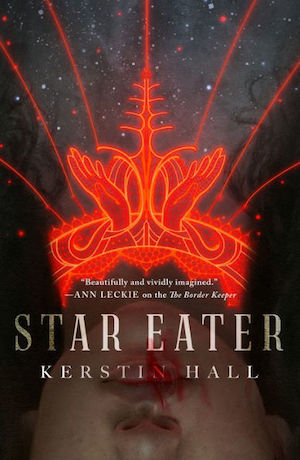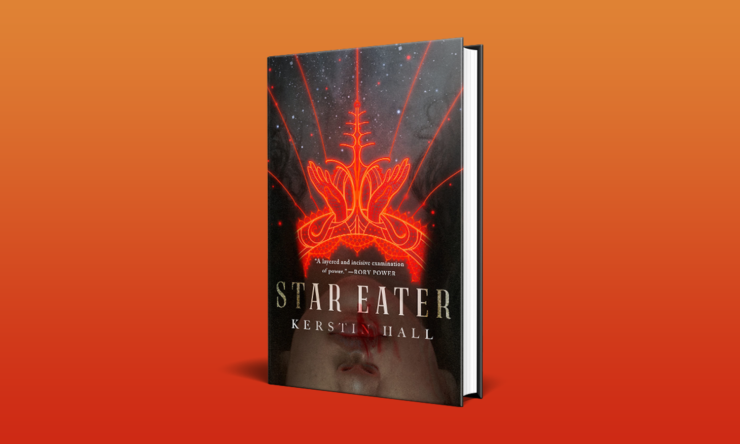Engrossing, horrifying, and vivid, Kerstin Hall’s debut novel Star Eater is a hard one to talk about. This is in part simply because there’s so much there there—so much inventive worldbuilding, so much carefully structured power, so many things I want to exclaim over. As with many complicated things, it’s occasionally boiled down to something both accurate and not, a hook like “cannibal cat-riding nuns in space!”
This description isn’t wrong, but it’s nowhere near the whole picture, either. There are cats the size of horses; there are cannibal not-really-nuns and horrifying zombies (called Haunts); there is something weird about the world of Aytrium, with its Pillars and vague references to the Edge. But this isn’t a book about the meticulously created world. It’s about corrupted power, and the sacrifices necessary for change.
Star Eater expects you to pay attention from the very first scene, when we meet Acolyte Elfreda Raughn in the midst of what ought to be a typical day. The ritual she’s performing with other Sisters is casually discussed, but like so much else in this novel, central to the world Hall builds. In Aytrium, everything has a reason, a cause and effect, from the terrifying Haunts that appear in the fields to the food shortages to the visions that plague Elfreda.
There are no infodumps here, but there is a lot of backstory, carefully woven into the plot and revealed gradually as Elfreda is swept up into a complicated conspiracy that reaches to the very center of her world. Like all Sisters, Elfreda was born into the Order: their power is inherited and inescapable, and brings with it certain responsibilities, some of which are deeply distasteful. There are things Elfreda can live with—the Haunts, the bureaucracy, even the hallucinations. But when it comes to replenishing her lace (the magic power wielded by Sisters) and the Renewal ceremonies through which new Sisters are bred … El will never fully accept those things.
And it’s that resistance that sets her story in motion.
Buy the Book


Star Eater
There’s also a capital-R Resistance among the ordinary people of Aytrium, who don’t have an abundance of love for the Order. But while the Sisters’ power is absolute, it’s also fractured. The Resistance falls somewhat by the wayside, narratively speaking, because the Order is plenty busy tearing itself apart.
As Elfreda is drawn into the power struggles among Sisters, the details of her life begin to grow more important: There’s the mystery of her mother’s early martyring, the tragic story of her friends Mille and Finn’s parents, the horrible murder of her work supervisor. With so much at play, the sprawling cast can get a little hard to juggle, and some of the relationships never quite click. (Also, the gender/power divide makes me wonder how trans and nonbinary people fit into this world.)
But much of what interests me in Star Eater goes beyond the details, and the characters, and into the shape of the story. It begins slowly, a precisely paced adding-up of things that are weird (to us, or to Elfreda) or horrible or somehow out of tune. There’s a beautiful detail about a song the workers sing—and the much bloodier version of the lyrics that were sung years ago. Who changed them? How? And what were they hiding?
The shape of the story is a pyramid, and at the start we can only see the point, the things Elfreda notices as she goes about her increasingly tense days. There’s much she takes for granted, and a reader has to wait to fully understand. But as the novel progresses, it’s a steady passage downward, learning more, putting pieces together, revealing more of the whole, until at the end, so much happens so quickly that at first, it feels a little rushed.
But this is a story about change centuries in the making. The tale began with the Eater herself, a figure now passed mostly into myth, who saved Aytrium hundreds of years ago. It ends with Elfreda, whose role is somewhat foreordained and yet also up to her. The arc of the story is the arc of this whole world’s existence. It takes time to build a new world, to lift it up from the ruins of the old. It takes much less time to tear it all down again.
Star Eater is a magical consideration of what it means to destroy a power structure. It’s an intimate, gripping exploration of what people are willing to do to maintain the systems that they believe maintain the world; it’s also a story that asks what doors might be opened if we could truly envision a world unlike the one we live in now.. Hall mixes her unique worldbuilding with familiar tropes—the chosen one, the love triangle(ish), the conspiracy, the mentor figures, the loss of a mother—and the combination creates a book that feels both familiar and unnervingly strange.
It’s a struggle to think of a book that Star Eater is more than vaguely comparable to. There is one scene that recalls a ghastly twist on an element from The Handmaid’s Tale, and Hall’s immersive worldbuilding reminded me just a bit of N.K. Jemisin’s The Fifth Season, on a smaller and far less geologic scale. But I read Star Eater right on the heels of Hannah Whitten’s For the Wolf, and saw unexpected parallels between the two: worlds where women have power but it’s still used against them; stories that make explicit a struggle between power and freedom, power and choice. Both are books that say this is how it’s been, but not how it has to be—and stories about how in order to rebuild, you have to be willing to face the truth of what came before.
Star Eater is available from Tordotcom Publishing.
Read an excerpt here.
Molly Templeton lives and writes in Oregon, and spends as much time as possible in the woods. You can also find her on Twitter.










